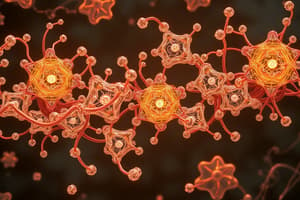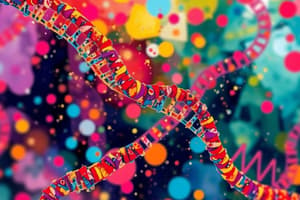Podcast
Questions and Answers
What is the purpose of insertional inactivation in identifying transformed cells?
What is the purpose of insertional inactivation in identifying transformed cells?
- To produce a color change in transformed cells
- To introduce the desired gene into the coding region of DNA
- To inactivate the enzyme β-galactosidase (correct)
- To identify recombinant colonies
What is the chromogenic substrate used in the insertional inactivation method?
What is the chromogenic substrate used in the insertional inactivation method?
- Lactose
- Galactose
- X-gal (correct)
- IPTG
What is the role of the Agrobacterium tumefaciens in cloning plants?
What is the role of the Agrobacterium tumefaciens in cloning plants?
- It is responsible for producing chemicals that the pathogen requires
- It transforms normal plant cells into a tumor
- It carries the T-DNA region that is inserted into the plant genome (correct)
- It is used as a vector to carry the desired gene into plant cells
What is the purpose of an antibiotic resistance gene in a cloning vector?
What is the purpose of an antibiotic resistance gene in a cloning vector?
What is the function of the origin of replication in a cloning vector?
What is the function of the origin of replication in a cloning vector?
What is the purpose of the cloning site in a vector?
What is the purpose of the cloning site in a vector?
What is the purpose of the T-DNA region carried by Agrobacterium tumefaciens?
What is the purpose of the T-DNA region carried by Agrobacterium tumefaciens?
Which of the following is a common selectable marker used in cloning vectors?
Which of the following is a common selectable marker used in cloning vectors?
What is the purpose of the β-galactosidase enzyme in the insertional inactivation method?
What is the purpose of the β-galactosidase enzyme in the insertional inactivation method?
What is the role of the origin of replication in a cloning vector?
What is the role of the origin of replication in a cloning vector?
Flashcards
Plasmid origin of replication
Plasmid origin of replication
A specific DNA sequence that allows plasmid replication within a host cell.
Selectable marker
Selectable marker
A gene that helps scientists identify cells that have taken up a plasmid.
Cloning vector
Cloning vector
A DNA molecule used to clone a particular gene or DNA segment.
Plant cell transformation
Plant cell transformation
Signup and view all the flashcards
Insertional inactivation
Insertional inactivation
Signup and view all the flashcards
Competent host cells
Competent host cells
Signup and view all the flashcards
Ti plasmid
Ti plasmid
Signup and view all the flashcards
Recombinant
Recombinant
Signup and view all the flashcards
Antibiotic resistance gene
Antibiotic resistance gene
Signup and view all the flashcards
Cloning site
Cloning site
Signup and view all the flashcards
Study Notes
Plasmids as Cloning Vectors
- A plasmid consists of an origin of replication, which allows for the replication of DNA fragments in the host cell.
- Plasmids also contain an antibiotic resistance gene, which acts as a selectable marker to identify transformed cells.
Features of Cloning Vectors
- A cloning vector requires an origin of replication (ori) for DNA replication and maintenance.
- A selectable marker is necessary to identify transformed cells, such as antibiotic resistance genes (e.g., ampicillin, chloramphenicol, tetracycline, or kanamycin).
- A cloning site is required for the insertion of foreign DNA.
Cloning Process
- The antibiotic resistance gene is replaced with the desired gene at the cloning site, resulting in the loss of antibiotic resistance.
- Recombinants can be selected from non-recombinants based on the loss of antibiotic resistance.
Plant Cell Transformation
- The tumor-inducing (Ti) plasmid of Agrobacterium tumefaciens is modified into a cloning vector for plant cells.
- The desired gene is introduced along with other required genes into the T-DNA, resulting in plant cell transformation.
- The Ti plasmid contains genes for growth regulators, cytokinin and auxin, and energy sources for opine catabolism.
Animal Cell Transformation
- Retroviruses have been modified to act as vectors for animal cells.
Competent Host Cells
- Bacterial cells must be made competent to take up DNA, which can be achieved through treatment with divalent ions (e.g., calcium ions) and heat shock.
- Competent cells can be used for DNA insertion through microinjection, biolistics, gene gun, or other methods.
Insertional Inactivation
- Insertional inactivation is a method used to identify transformed cells by inserting a gene into the coding sequence of an enzyme, β-galactosidase.
- The resulting inactivation of the enzyme prevents the formation of lactose, allowing for the identification of recombinant colonies.
Vectors for Plant Cloning
- Agrobacterium tumefaciens is used as a vector for plant cells, carrying the T-DNA that results in plant cell transformation.
Studying That Suits You
Use AI to generate personalized quizzes and flashcards to suit your learning preferences.




